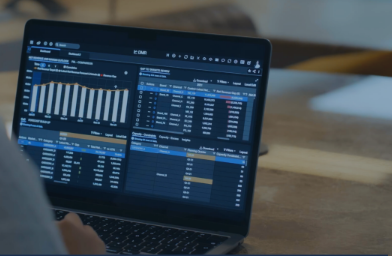o9 Solutions’ Commitment to Sustainability in Software
Start Reading

1. Company at a Glance
This case study delves into how o9 Solutions embraced sustainability within the software sector, setting bold science-based targets (SBTs) to create lasting impact. By leveraging innovative tools, cutting emissions, and fostering collaboration, the company is paving the way for a more sustainable future in technology.
Software
Industry
2009
Founded
United States
Headquarter
Over 3,000
Number of Employees
Operates globally, including European, Asian and Latin American countries
Global Presence
2. The Challenge
The global software industry generates significant emissions, particularly from the use of data centers, making strong climate action essential. To contribute to this global challenge, o9 Solutions decided to align its business goals with international sustainability objectives.
The main challenges faced were:
- Limited availability and reliability of Scope 3 data from suppliers, making it difficult to accurately measure emissions and track progress.
- Reducing Scope 3 Category 1 emissions, which represent by far the largest share, is particularly challenging as they lie upstream, largely outside the company's direct control.
- Increasing expectations from clients, investors, and stakeholders for credible, transparent, and science-aligned sustainability performance.
After identifying the challenges and ensuring stakeholder alignment, o9 concluded that validated Science-Based Targets (SBTs) and reliable data were critical differentiators in the market.
3. The Action
To meet its validated SBTs, o9 Solutions has implemented a comprehensive climate strategy based on several key pillars:
Setting Clear Targets
- Short-term target (by 2030): Reduce absolute Scope 1 and 2 greenhouse gas (GHG) emissions by 50%, based on a 2022 baseline.
- Supplier engagement target (by 2028): Ensure that 90% of suppliers have adopted science-based targets.
- Long-term target (by 2040): Achieve net-zero GHG emissions across the entire value chain, including a 90% absolute reduction in Scope 1, 2, and 3 emissions from the 2022 baseline.
Scope 2 Emissions Strategy
o9 Solutions encouraged its leased offices to transition to renewable energy sources and obtain renewable energy certificates. For the portion of consumption not yet covered by renewables, the company purchased certified Energy Attribute Certificates (EACs), tailored to the country or region where each office is located.
As 2024 marked the first calendar year for EAC procurement, o9 Solutions partnered with a specialized company to source EACs for offices representing the majority of emissions. One of the company’s investors supported the process by helping identify the appropriate partner for EAC sourcing.
Scope 3 Emissions Strategy
o9 Solutions launched a Supplier Engagement Program to address its largest source of emissions—Scope 3, Category 1, which according to the Greenhouse Gas Protocol, refers to the "cradle-to-gate" greenhouse gas emissions from the production of purchased goods and services—by establishing clear and measurable expectations for its suppliers. This program included time-bound requirements such as reporting annual carbon footprints and committing to the Science-Based Targets initiative (SBTi).
Suppliers were categorized according to their level of maturity in sustainability practices, enabling o9 Solutions to provide differentiated support. For key suppliers such as data center providers—organizations already advanced in their sustainability journey—the company applied a tailored approach. These suppliers often had existing ESG reporting, from which o9 extracted actual emissions data to incorporate into its footprint calculations.
For other suppliers with publicly available ESG reports, the company used reported data directly. In cases where suppliers lacked emissions reporting, o9 Solutions established direct relationships to support them in calculating their footprints. This included capacity-building initiatives and guidance to help them develop actionable emissions reduction plans and track progress against defined targets.
Internally, o9 Solutions used analytics tools to continuously monitor the carbon footprint of its supplier network.
Internal Collaboration
o9 Solutions created a Sustainability Council led by the Sustainability team and composed of representatives from Procurement, Legal, Finance, Product Management, Development, Security, IT, HR, and Client Management. This council was responsible for integrating sustainability considerations into company-wide decision-making.
Moreover, executive leadership is consulted on a bi-annual basis on the strategy and performance of our sustainability program.
External Collaboration
o9 Solutions collaborated with external assurance and consulting firms, as well as investors, who provided key guidance and resources throughout the process. The company conducts annual assurance certification of its metrics through SGS United Kingdom, Ltd to ensure data accuracy and validity.
Regular communication is maintained with investors to co-develop targets and share updates on emissions calculations, disclosure practices, ESG frameworks and progress. Investors also supported the process by offering webinars and workshops to help ensure alignment with regulatory requirements.
Innovation and Advocacy
o9 Solutions participates in collaborative platforms such as the Sustainable Procurement Pledge and the Scope 3 Peer Group to exchange knowledge and best practices. The company is also a signatory of the Climate Pledge, leveraging practical tools for climate transition strategies.
4. Next Steps
o9 Solutions plans to expand its Supplier Engagement Program to accelerate progress on Scope 3 emissions reduction targets. In parallel, the company will develop and implement internal policies to encourage sustainable behavior among employees, including business travel guidelines. Additionally, o9 Solutions will introduce Environmental Training Awareness initiatives across its global workforce to strengthen sustainability awareness.
5. Impact & Results
Emissions Reduction
Achieved a 96.82% reduction in scope 2 emissions by 2024 compared to 2022 through renewable energy and EACs. Reduced scope 3 emissions by 13.04% in category 1 by improving supplier data accuracy.
External Recognition
Validated SBTs by the SBTi, enhancing credibility and visibility in the industry.
Internal Alignment
Employees actively supported implementation, from office-level initiatives to data collection, fostering a culture of sustainability.
Brand Visibility
Participation in platforms like the Sustainable Procurement Pledge and Scope 3 peer group boosted
o9’s reputation as a sustainability leader.
6. Key Lessons Learned
Start with a simple, actionable plan and iterate as you learn, rather than waiting for perfection.
Invest in tools to visualize emissions hotspots and align stakeholders early for success.
Engage suppliers proactively to build capacity and drive scope 3 reductions.
Assure data early to enhance credibility and avoid blind spots.
"Our ambition is to enable sustainable decision-making for our clients while leading by example in our own operations."
Christina Andreou, Director of Global Sustainability, o9 Solutions
o9 Solutions’ commitment to UN Global Compact initiatives
Signatory of the Forward Faster initiative on Climate Action Target 1
Participant of the SDG Innovation Accelerator
Participant of The Climate Ambition Accelerator
Recommended UN Global Compact resources to support your journey:

